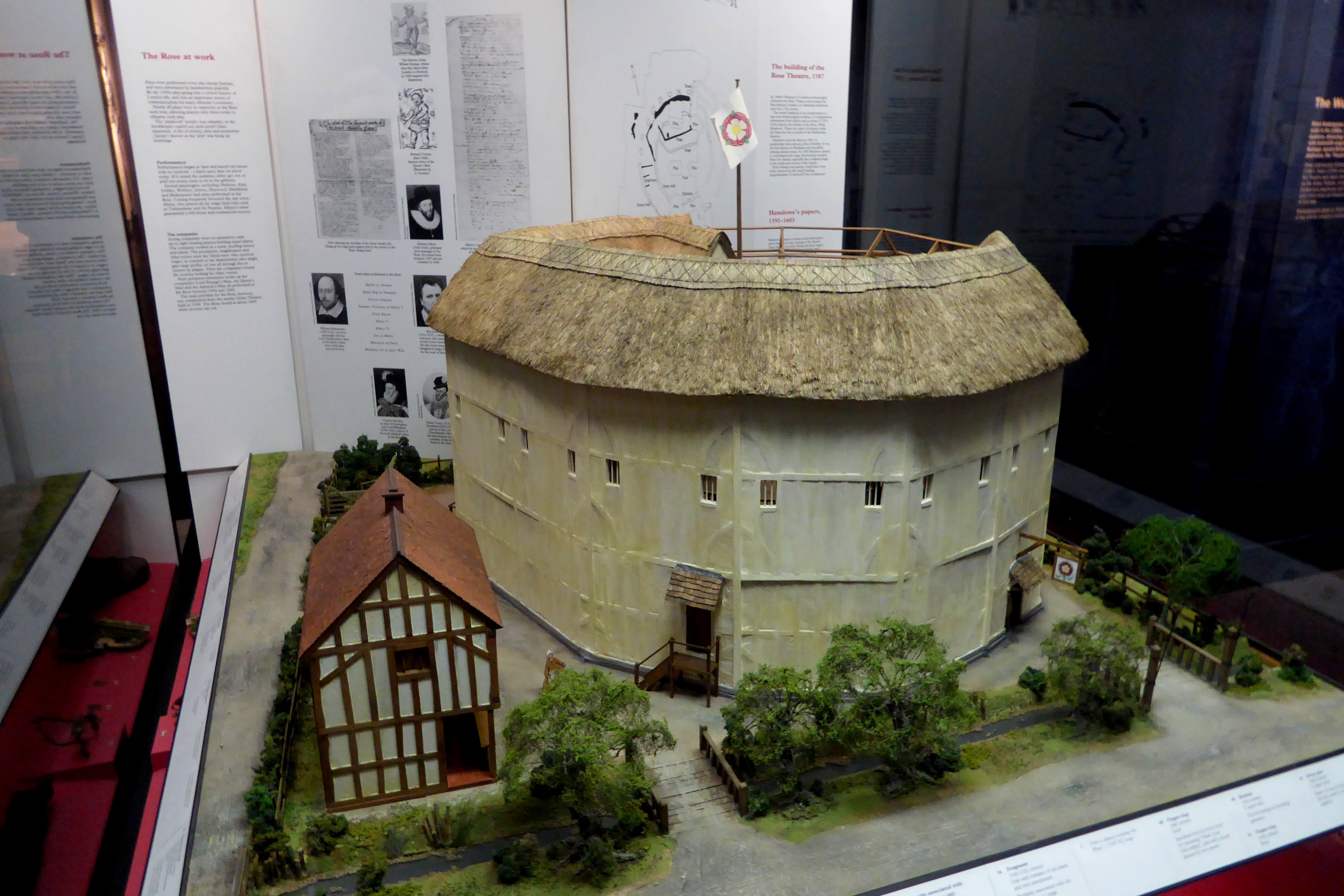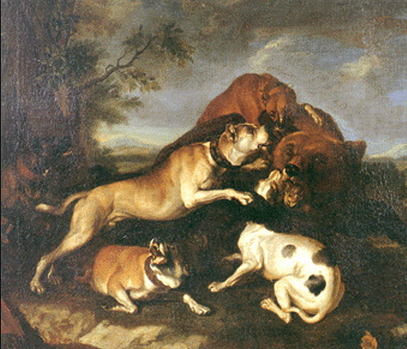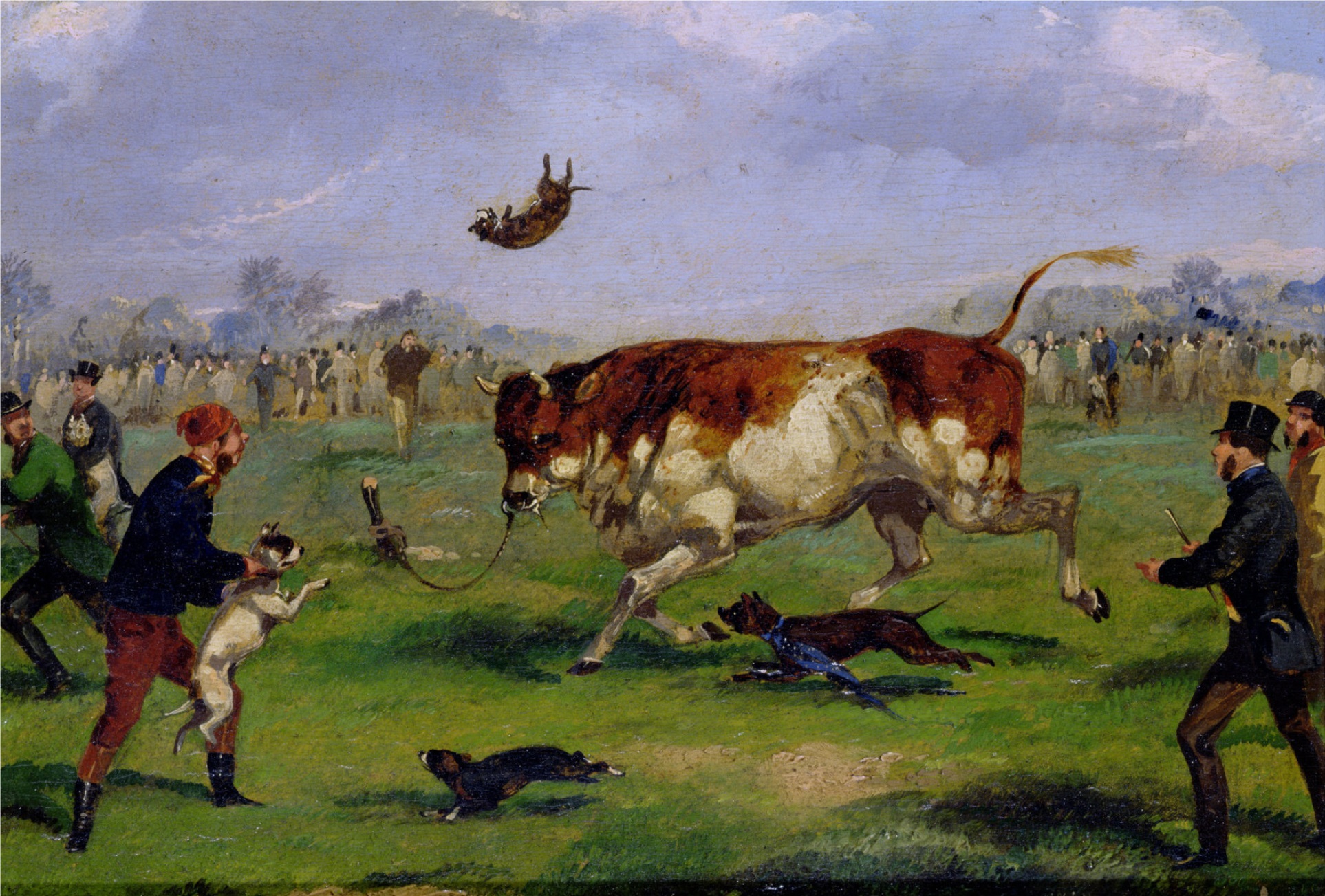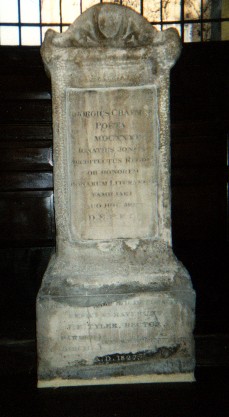|
Beargarden
The Beargarden was a facility for bear-baiting, bull-baiting, and other " animal sports" in the London area during the 16th and 17th centuries, from the Elizabethan era to the English Restoration period. Baiting is a blood sport where an animal is tormented or attacked by another animal, often dogs, for the purpose of entertainment or gambling. Samuel Pepys visited the venue in 1666 and described it as "a rude and nasty pleasure". The last recorded event at the Beargarden was the baiting of "a fine but vicious horse" in 1682. History The Beargarden was constructed as a round or polygonal open structure, comparable to the public theatres built in and around London starting in 1576. Contemporaneous illustrated maps of the city show a substantial three-storey building that resembles the theatres nearby. It was located in the Bankside, across from the City of London on the south bank of the River Thames in Southwark; but its exact location is unclear, and apparently changed ov ... [...More Info...] [...Related Items...] OR: [Wikipedia] [Google] [Baidu] [Amazon] |
Philip Henslowe
Philip Henslowe ( – 6 January 1616) was an Elizabethan theatrical entrepreneur and impresario. Henslowe's modern reputation rests on the survival of his diary, a primary source for information about the theatrical world of Renaissance London. Life Henslowe was born in Lindfield, Sussex, into a family with roots in Devon. His father, Edmund Henslowe, was appointed Master of the Game for Ashdown Forest, Sussex, from 1539 until his death in 1562. Before Edmund Henslowe's death, his daughter Margaret had married Ralf Hogge, an ironmaster. By the 1570s, Henslowe had moved to London, becoming a member of the Dyers' Company. Henslowe is recorded working as assistant to Henry Woodward, reputed to be the bailiff for Anthony Browne, 1st Viscount Montagu, owner of Cowdray House and Battle Abbey in Sussex. Henslowe married Woodward's widow, Agnes, and from 1577 lived in Southwark, opposite the Clink prison. His elder brother Edmund, a merchant, also owned property in Southwark. ... [...More Info...] [...Related Items...] OR: [Wikipedia] [Google] [Baidu] [Amazon] |
The Rose (theatre)
The Rose was an Elizabethan theatre, Elizabethan playhouse, built by theatre entrepreneur Philip Henslowe in 1587. It was the fifth public playhouse to be built in London, after the Red Lion (theatre), Red Lion in Whitechapel (1567), The Theatre (1576) and the Curtain Theatre, Curtain (1577), both in Shoreditch, and the Newington Butts Theatre, theatre at Newington Butts () – and the first of several playhouses to be situated in Bankside, Southwark, in a Liberty (division), liberty outside the jurisdiction of the City of London's civic authorities. Two of the earliest plays by William Shakespeare – Titus Andronicus and Henry VI, Part 1 – are recorded as having been performed there, as well as plays by dramatists such as Christopher Marlowe, Thomas Kyd, Robert Greene (dramatist), Robert Greene, George Peele, Thomas Dekker (writer), Thomas Dekker, Michael Drayton, Ben Jonson and Thomas Heywood. The Rose's archaeological remains were rediscovered in 1989 during the redevelopme ... [...More Info...] [...Related Items...] OR: [Wikipedia] [Google] [Baidu] [Amazon] |
Bear-baiting
Bear-baiting was a historical blood sport in which a chained bear and one or more dogs were forced to fight one another. It also sometimes involved pitting a bear against another animal. Until the 19th century, it was commonly performed in Great Britain, Sweden, India, Pakistan, and Mexico among others. Today, "bear-baiting" most commonly refers to the practice of using edible bait to lure bears into an area for hunting. Bear-baiting in all forms has been subject to controversy and debate among animal rights advocates for centuries. History Europe Great Britain Bear-baiting was very popular from the 12th until the 19th century. From the 16th century, many bears were maintained for baiting. In its best-known form, arenas for this purpose were called bear-gardens, consisting of a circular high fenced area, the " pit", and raised seating for spectators. A post would be set in the ground towards the edge of the pit and the bear chained to it, either by the leg or neck. Severa ... [...More Info...] [...Related Items...] OR: [Wikipedia] [Google] [Baidu] [Amazon] |
Bull-baiting
Bull-baiting (or bullbaiting) is a blood sport involving pitting a bull against dogs with the aim of attacking and subduing the bull by biting and holding onto its nose or neck, which often resulted in the death of the bull. History England The origin of baiting in England may have come from ancient pagan rituals, and appears to have been carried on as a required method of butchering bull-beef in the 14th century. However, the earliest known bull-baiting as commercial entertainment in London was around 1540, and the first permanent arena was in 1562. Historically, however, English authors have often claimed a more ancient origin of the sport, as early as the 12th century, presumably to lend it a more ancient and venerable history, going as far as to suggest that the circular shape of the Elizabethan theaters came about because they were first used as baiting arenas, although these claims have been discredited. Crowds in London during the Royal Entry of James VI and I in Mar ... [...More Info...] [...Related Items...] OR: [Wikipedia] [Google] [Baidu] [Amazon] |
Elizabeth I Of England
Elizabeth I (7 September 153324 March 1603) was Queen of England and Ireland from 17 November 1558 until her death in 1603. She was the last and longest reigning monarch of the House of Tudor. Her eventful reign, and its effect on history and culture, gave name to the Elizabethan era. Elizabeth was the only surviving child of Henry VIII and his second wife, Anne Boleyn. When Elizabeth was two years old, her parents' marriage was annulled, her mother was executed, and Elizabeth was declared illegitimate. Henry restored her to the line of succession when she was 10. After Henry's death in 1547, Elizabeth's younger half-brother Edward VI ruled until his own death in 1553, bequeathing the crown to a Protestant cousin, Lady Jane Grey, and ignoring the claims of his two half-sisters, Mary and Elizabeth, despite statutes to the contrary. Edward's will was quickly set aside and the Catholic Mary became queen, deposing Jane. During Mary's reign, Elizabeth was imprisoned fo ... [...More Info...] [...Related Items...] OR: [Wikipedia] [Google] [Baidu] [Amazon] |
Richard III Of England
Richard III (2 October 1452 – 22 August 1485) was King of England from 26 June 1483 until his death in 1485. He was the last king of the Plantagenet dynasty and its cadet branch the House of York. His defeat and death at the Battle of Bosworth Field marked the end of the Middle Ages in England. Richard was created Duke of Gloucester in 1461 after the accession to the throne of his older brother Edward IV. This was during the period known as the Wars of the Roses, an era when two branches of the royal family contested the throne; Edward and Richard were Yorkists, and their side of the family faced off against their Lancastrian cousins. In 1472, Richard married Anne Neville, daughter of Richard Neville, 16th Earl of Warwick, and widow of Edward of Westminster, son of Henry VI. He governed northern England during Edward's reign, and played a role in the invasion of Scotland in 1482. When Edward IV died in April 1483, Richard was named Lord Protector of the realm for Ed ... [...More Info...] [...Related Items...] OR: [Wikipedia] [Google] [Baidu] [Amazon] |
Puritan
The Puritans were English Protestants in the 16th and 17th centuries who sought to rid the Church of England of what they considered to be Roman Catholic practices, maintaining that the Church of England had not been fully reformed and should become more Protestant. Puritanism played a significant role in English and early American history, especially in the Protectorate in Great Britain, and the earlier settlement of New England. Puritans were dissatisfied with the limited extent of the English Reformation and with the Church of England's religious toleration of certain practices associated with the Catholic Church. They formed and identified with various religious groups advocating greater purity of worship and doctrine, as well as personal and corporate piety. Puritans adopted a covenant theology, and in that sense they were Calvinists (as were many of their earlier opponents). In church polity, Puritans were divided between supporters of episcopal, presbyterian, and ... [...More Info...] [...Related Items...] OR: [Wikipedia] [Google] [Baidu] [Amazon] |
Walter Raleigh
Sir Walter Raleigh (; – 29 October 1618) was an English statesman, soldier, writer and explorer. One of the most notable figures of the Elizabethan era, he played a leading part in English colonisation of North America, suppressed rebellion in Ireland, helped defend England against the Spanish Armada and held political positions under Elizabeth I. Raleigh was born to a landed gentry family of Protestant faith in Devon, the son of Walter Raleigh and Catherine Champernowne. He was the younger half-brother of Sir Humphrey Gilbert and a cousin of Sir Richard Grenville. Little is known of his early life, though in his late teens he spent some time in France taking part in the religious civil wars. In his 20s he took part in the suppression of rebellion in the colonisation of Ireland; he also participated in the siege of Smerwick. Later, he became a landlord of property in Ireland and mayor of Youghal in east Munster, where his house still stands in Myrtle Grove. He rose ... [...More Info...] [...Related Items...] OR: [Wikipedia] [Google] [Baidu] [Amazon] |
The Conspiracy And Tragedy Of Charles, Duke Of Byron
''The Conspiracy and Tragedy of Charles, Duke of Byron, Marshall of France'' is a Jacobean tragedy by George Chapman, a two-part play or double play first performed and published in 1608. It tells the story of Charles de Gontaut, duc de Biron, executed for treason in 1602. Genre The two plays that comprise the larger work, ''The Conspiracy of Byron'' and ''The Tragedy of Byron'', can also be described as "contemporary history;" they form the second and third installments in a series of dramas that Chapman wrote on French politics and history in his time, from ''Bussy D'Ambois'' through ''The Tragedy of Chabot, Admiral of France''. Date and performance In all likelihood, Chapman composed both parts of ''Byron'' in 1607–8; his primary source on the political events portrayed in the plays, Edward Grimeston's ''A General Inventory of the History of France'', was first published in 1607. The plays were first acted by the Children of the Chapel (by 1608 known as the Children of t ... [...More Info...] [...Related Items...] OR: [Wikipedia] [Google] [Baidu] [Amazon] |
George Chapman
George Chapman ( – 12 May 1634) was an English dramatist, translator and poet. He was a classical scholar whose work shows the influence of Stoicism. Chapman is seen as an anticipator of the metaphysical poets of the 17th century. He is best remembered for his translations of Homer's ''Iliad'' and '' Odyssey'', and the Homeric '' Batrachomyomachia''. Shakespeare was a contemporary of Chapman, and there is evidence that he knew some of Chapman's work. William Minto proposed Chapman as a candidate for being the " Rival Poet" mentioned in Shakespeare's sonnets. Life and work Chapman was born at Hitchin in Hertfordshire. His father appears to have been reasonably well off, but George was the younger son, and would need to earn his living. From his literary work it is evident that he acquired a good command of Latin and Greek (although he drew on the work of earlier scholars in his Greek translations). There is conjecture that he attended the University of Oxford without t ... [...More Info...] [...Related Items...] OR: [Wikipedia] [Google] [Baidu] [Amazon] |
Court Of Exchequer Chamber
The Court of Exchequer Chamber was an English appellate court for common law civil actions before the reforms of the Judicature Acts of 1873–1875. It originated in the fourteenth century, established in its final form by the Error From Queen's Bench Act 1584 ( 27 Eliz. 1. c. 8). The court heard references from the King's Bench, the Court of Exchequer and, from 1830, directly rather than indirectly from the Court of Common Pleas. It was constituted of four judges belonging to the two courts that had been uninvolved at first instance. In cases of exceptional importance such as the '' Case of Mines'' (1568) and '' R v Hampden'' (1637) twelve common law judges, four from each division below, sitting in Exchequer Chamber, might be asked to determine a point of law, the matter being referred by the court hearing the case rather than the parties. Though further appeal to the House of Lords was possible, this was rare before the nineteenth century. As a rule, a judgment of the Ex ... [...More Info...] [...Related Items...] OR: [Wikipedia] [Google] [Baidu] [Amazon] |
John Taylor (poet)
John Taylor (24 August 1578 – December 1653) was an English poet who dubbed himself "The Water Poet". Biography John Taylor was born in the parish of St. Ewen's, near South Gate, Gloucester on 24 August 1578. His parentage is unknown, as the parish registers did not survive the Civil War. He did, however, attend elementary school and grammar school there. His grammar school education may have taken place at the Crypt School in Gloucester, however Taylor never finished his formal education due to difficulties with his Latin studies. In the early 1590s, after his attempt at grammar school he moved from his home to south London, probably Southwark, to begin an apprenticeship as a waterman. His occupation was one deemed unpopular by the literary elite of London. Watermen were known to be drunkards, and often gossips and liars, who attempted to cheat patrons into a higher wage for their service. This occupation would be crafted into an image for Taylor later in his career. After h ... [...More Info...] [...Related Items...] OR: [Wikipedia] [Google] [Baidu] [Amazon] |








